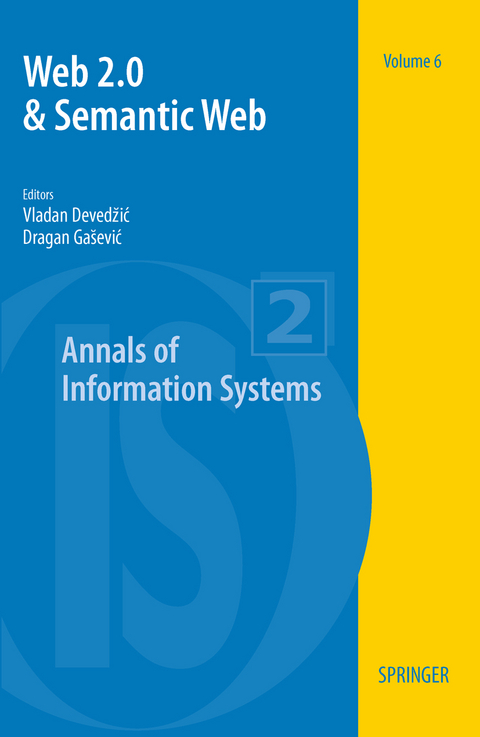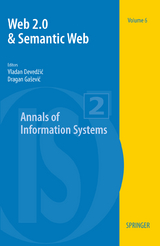Web 2.0 & Semantic Web
Springer-Verlag New York Inc.
978-1-4419-1218-3 (ISBN)
According to the W3C Semantic Web Activity [1]: The Semantic Web provides a common framework that allows data to be shared and reused across appli- tion, enterprise, and community boundaries. This statement clearly explains that the Semantic Web is about data sharing. Currently, the Web uses hyperlinks to connect Web pages. The Semantic Web goes beyond that and focuses on data and envisions the creation of the web of data. On the Semantic Web, anyone can say anything about any resource on the Web. This is fully based on the concept of semantic - notations, where each resource on the Web can have an assigned meaning. This is done through the use of ontologies as a formal and explicit representation of domain concepts and their relationships [2]. Ontologies are formally based on description logics. This enables agents and applications to reason over the data when searching the Web, which has not previously been possible. Web 2. 0 has gradually evolved from letting the Web users play a more active role. Unlike the initial version of the Web, where the users mainly “consumed” content, users are now offered easy-to-use services for content production and publication. Mashups, blogs, wikis, feeds, interface remixes, and social networking/tagging s- tems are examples of these well-known services. The success and wide adoption of Web 2. 0 was in its reliance on social interactions as an inevitable characteristic of the use and life of the Web. In particular, Web 2.
Vladan Devedzic is a Professor of computer science at the University of Belgrade, FON - School of Business Administration, Department of Information Systems and Technologies. He has also taught at the University of Belgrade School of Electrical Engineering, Department of Computer Engineering, as well as at the Military Academy of Serbia (the former Yugoslav Military Academy). His professional goal is to bring together the ideas from the broad fields of intelligent systems and software engineering. His current professional and scientific interests include knowledge modeling, ontologies, intelligent reasoning techniques, Semantic Web, software engineering, and the application of artificial intelligence to education and medicine. More information on Prof. Devedzic is available at the website: http://fon.fon.bg.ac.yu/~devedzic/ Dragan Gaševic taught at the University of Belgrade (2000-2005) before transferring to Simon Fraser University in Canada, where he was a Postdoctoral Fellow at the School of Interactive Arts and Technology involved in the LORNET project funded by the Natural Science and Engineering Research Council of Canada (NSERC). He is currently an Adjunct Professor at the Interactive School of Arts & Technology at Simon Fraser University as well as an Assistant Professor in the School of Computing and Information Systems at Athabasca University. His research interests include model driven software engineering; knowledge management and Semantic Web; interoperability and integration of systems, data, and modeling technologies; technology-enhanced learning (e-learning); and Petri nets. For more information about Prof. Gaševic, please go the following website: http://scis.athabascau.ca/scis/staff/index.jsp?ct=dragang&sn=faculty
Tagging and Semantics.- TagFusion: A System for Integration and Leveraging of Collaborative Tags.- Semantic Enhancement of Social Tagging Systems.- Adaptability and User Interfaces.- Adaptation and Recommendation Techniques to Improve the Quality of Annotations and the Relevance of Resources in Web 2.0 and Semantic Web-Based Applications.- Adaptive Reactive Rich Internet Applications.- Knowledge Representation and User Interfaces.- Towards Enhanced Usability of Natural Language Interfaces to Knowledge Bases.- Semantic Document Model to Enhance Data and Knowledge Interoperability.- Data Mining, Software Engineering, and Semantic Web.- Ontology-Based Data Mining in Digital Libraries.- An Assessment System on the Semantic Web.
| Reihe/Serie | Annals of Information Systems ; 6 |
|---|---|
| Zusatzinfo | 52 Illustrations, black and white; XX, 206 p. 52 illus. |
| Verlagsort | New York, NY |
| Sprache | englisch |
| Maße | 155 x 235 mm |
| Themenwelt | Mathematik / Informatik ► Informatik ► Netzwerke |
| Mathematik / Informatik ► Informatik ► Web / Internet | |
| Informatik ► Weitere Themen ► Hardware | |
| Mathematik / Informatik ► Mathematik ► Finanz- / Wirtschaftsmathematik | |
| ISBN-10 | 1-4419-1218-5 / 1441912185 |
| ISBN-13 | 978-1-4419-1218-3 / 9781441912183 |
| Zustand | Neuware |
| Haben Sie eine Frage zum Produkt? |
aus dem Bereich




